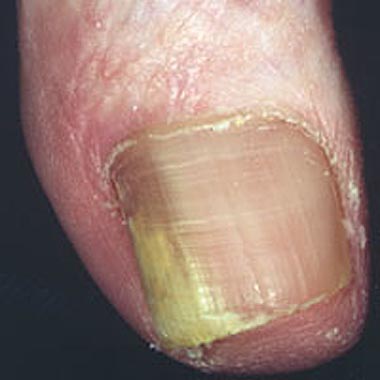Onychomycosis: Treatment of infection caused by fungi
Onychomycosis, infection caused by fungi, can affect both toenails and hands. Easily identifiable, as we shall see, this is a condition that should be diagnosed and treated. What is the indicated treatment and that symptoms the snitch? Let’s look more closely at how to strengthen the nail care to prevent these infections.
Onychomycosis in medical terms, is a nail infection that is caused by fungi (yeasts, molds and dermatophytes). Infection is more common than we think, and in fact, according to medical data, it is estimated that 20% of the population suffers from onychomycosis.
Its outward symptoms are easily recognizable – staining yellowish that will eventually extend and lift the nail, so it is a disease that is diagnosed without problems. The surface area of the nails of hands and feet are the most affected, although the degree of involvement may extend to other layers of the nail (may cause their loss) and even fingers. Depending on the type of fungus that has unleashed the infection will recommend one or another treatment.
Treatment of onychomycosis is crucial, because we have an infection which can have its consequences, from loss of fingernails until the pain that goes with it. In fact, if it is not treated properly it can transmit infection to other areas of the body, especially in the cases of patients with a weakened immune system.
Table of Contents
Onychomycosis symptoms
The signals that can make us suspect a fungal infection in the nails are:
- Abnormal thickening of the nail.
- Bubble formation or deformation of fingernail.
- The nail takes on a yellowish and dark hue.
- Brittle nails with a tendency to break.
- Nail of opaque color, without brightness.
- Pain in the fingers or toes, and above all, in the diseased nail, which also may give off unpleasant smell.
- Lifting of the nail bed to the nail.
Onychomycosis: Causes and risk factors
The causes of onychomycosis (tinea unguium), as noted, are directly linked to the action of some fungi. Onychomycosis can affect the matrix (i.e., the root) of the nails. The fungi usually need a habitat more hot and humid, making it easier for the infection to occur in the feet, especially in the nail of the big toe. Fungi can creep underneath the nail and cause microabrasion before starting to proliferate. Among the risk factors or factors that have more susceptible to the occurrence of nail fungus can talk about:
- Showers and areas that we walked barefoot at swimming pools and gyms
- Humid
- Certain skin diseases such as psoriasis, make us more vulnerable to onychomycosis
- Wearing socks and shoes to prevent foot perspiration
- Other infections of the feet, such as ingrown toenail
- Diabetes
- HIV
See More: Natural cure for ingrown toenail
Onychomycosis: pharmacological remedies
What are the remedies to cure onychomycosis? The doctor usually will prescribe antifungal for oral use, for a period sufficient to eradicate the infection (treatment can last more than a month). These drugs also stimulate the growth of a new nail to replace the infected nail. The onychomycosis treatment does not end with oral drugs, but also often recommended for topical antifungal products. The laser can be useful, in particular photodynamic therapy to treat diseased nail.
Note: You should consult with your doctor before taking any drugs.
